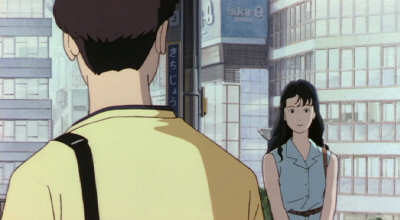
 "And it was then that I realized...I had always been crazy for her."
"And it was then that I realized...I had always been crazy for her."Umi Ga Kikoeru finishes with a climax that's truly moving, a dramatic punch-line after a long, engaging story. More likely than not, it's the scene that will linger in your mind the longest. At least, that's been the case with me; it's a grand, sweeping romantic gesture, literally sweeping.
It's a great construction. The whole film is building, building, building to the climax. Anyone who knows drama or comedy, truly knows it in their bones, will tell you how important it is for the punch-line to contrast against the set-up. This is a crucial lesson for anyone who wants to write novels or make movies. Something like this just isn't possible from today's brain-sucking Hollywood blockbusters. There's never any contrast, any proper build-up; no, it's all punch-line. It's all endless explosions and rapid-fire cuts. BoomBoomBoomBoomBoomBoomBoom!!!!!
Kids, this is why Master of Puppets is vastly superior to Kill 'Em All. It's all in the contrasts, the tempo shifts.
The climax to I Can Hear the Sea is a textbook lesson, taken straight from Yasujiro Ozu. Ozu became the master of zen filmmaking, of stripping away every excess, every concept, every notion. All that's left is the pure, unnamed experience.
Notice how scenes are assembled, with its casual pace, its long shots, its endless pillow shots. This brings us not only closer to the characters, by moving everything in a real-time tempo, it also allows us to contemplate, to meditate, to reflect. Umi is mostly told via flashback.
Notice how every shot is a static shot. The camera never moves once. And then we return to the train station, right where we began. Taku had once spied a girl he believed to be Rikako; now, having come to terms with himself, he spies her again. He won't let her get away this time. He sprints down the stairs, across the subway, and then up the stairs to the other side. Running out, he looks around, but cannot see her.
And then Taku turns his head. His eyes are fixed, the sounds of the train station melt away, and the camera swings around, sweeping in a circle to meet Rikako, who waits, smiling. Punch-line. Checkmate.
After an hour of stationary cameras, we have a circular rotation, 180 degrees in two cuts. It's an emotionally-charged climax, and it's about as satisfying a payoff as one can ask for. It's only possible when in concert with the rest of the film, and its long, slow buildup. A remarkable lesson learned from the young Ghibli staff - two degrees removed from Ozu.

1 comment:
Hai Daniel
Your style of appreciateing films are remarkable.Nice page.
Post a Comment